Report
Introduction
Last year, the third annual India Philanthropy Report by Bain & Company focused on the emerging generation of wealthy young philanthropists, many of whom are under 40 and have less than three years of philanthropic experience.
Key themes that emerged from last year’s report were:
• Foundations are the key distribution channel for donor contributions
• Younger relatives significantly influence their families’ charitable giving
• Young donors show higher potential than other age groups to increase their contributions
• Poor transparency and accountability on the part of philanthropy recipients inhibit the growth of contributions
A major focus of the India Philanthropy Report 2013 is to delve deeper into how charitable organisations assess the impact of their work, and how they can better communicate that impact to donors. We believe that this theme is relevant to all stakeholders within the philanthropic ecosystem and is critical to both optimising the outcomes of philanthropy and boosting confidence among donors. For giving to grow to its full potential in India, it will be of paramount importance to ensure that donors and recipients have a common language and common goals around results.
This year’s report explores the crucial and complex questions around the impact of giving. How is the impact of each rupee invested in philanthropic activities measured? How should it be measured? Can a better understanding of impact deliver better outcomes? And finally, can better communication around impact increase giving in any meaningful way?
To gain deeper insights into these questions, Bain surveyed 180 high-net-worth individuals (HNWIs1) across four major cities as well as leaders at more than 40 nongovernment organisations (NGOs). The survey findings are reinforced by approximately 20 detailed interviews with HNWIs and leaders at NGOs and foundations.
Our latest research revealed that many of the key trends identified in last year’s report continue to shape the philanthropic landscape. The top two areas of concern for philanthropists in 2012—providing food and clothing, and supporting education— remain the same this year, garnering attention from 78% and 74% of donors, respectively. Young donors also continue to be relevant. As the decision makers in 32% of households, they often set their family’s philanthropic vision.
The key objectives of this year’s report are:
- To understand the contours and complexities of philanthropic impact and how it differs by sector
- To identify factors that can generate greater impact from every philanthropic rupee Donated
The need for philanthropy is greater than ever
The history of philanthropic giving in India needs to be viewed through the larger macroeconomic lens. In the recent past, buoyant economic growth—near or above 7% for three years—has increased the Indian government’s ability to spend more on its less advantaged population. Private contributions have increased in tandem with GDP growth. As Bain’s Philanthropy Report 2012 revealed, India’s rich increased their contributions from 2.3% of household income in 2010 to 3.1% in 2011. In both our 2012 and 2013 research, the majority of donors indicated that they would likely increase their donations in the years ahead.
At the same time, we have witnessed rapid improvements in multiple key social indicators. In education, there is near-universal enrolment of children in schools at the primary level. Similarly in health, infant mortality rates declined from 64.9 for every 1,000 births in 2000 to 46.1 in 2012. Maternal mortality rates dropped 13% in two years, from 230 per 1,000 births in 2008 to 200 in 2010.
The challenges, however, remain robust. Despite higher enrolments, India’s young continue to be poorly educated and lacking in skills. For example, less than a third of school-going children in Class III can read a Class I text, according to the provisional 2013 report from Pratham, one of India’s largest education NGOs. On the public health front, India still ranks 134th among 187 nations on the United Nation’s Human Development Index, which includes maternal and child mortality. Medical resources remain sparse, and a World Health Statistics report counted India among the most likely countries to face a shortage of health workers.
Given the scale of the challenges, the state cannot address these issues all alone. Private philanthropic capital is vital. Yet India’s economic growth rate has recently declined to around 5.4%. This contraction in growth has led to donors putting a higher bar on understanding the impact of their giving before they commit to causes.
Ahead of the twin challenges of increased need and expected resource constraints, it is more vital than ever to improve the definitions of and expectations for philanthropic impact. More accountability and communication between stakeholders will stretch and direct the donations to accomplish more as well as foster a positive climate for greater giving in India.
Disconnect: Donors and NGOs hold different definitions of successful outcomes
On an optimistic note, there is broad consensus among donors and recipient NGOs that the work they fund or do is meaningful and leads to change.
A solid 80% of donors are satisfied with the effect of their contributions; Bain’s survey shows (see Figure 1). Similarly, 90% of the NGOs are satisfied with what they are accomplishing.
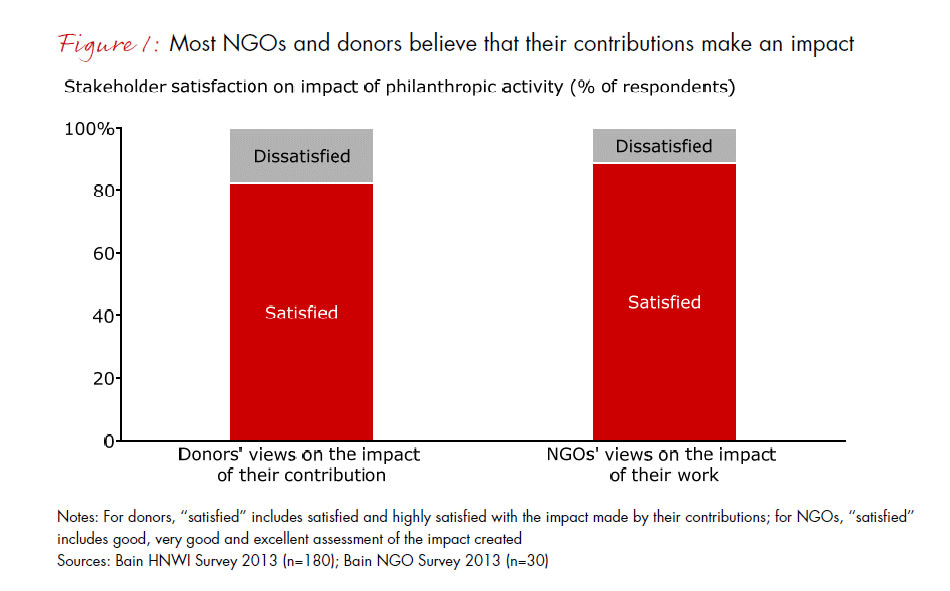
However, this agreement among donors and NGOs masks some deeper differences around the definition of impact, namely what needs to be measured and how.
Foundations and experts have a clear and structured view on impact. For example, London Business School research defines impact as “an outcome, less an estimate of what changes would have happened without any intervention”. Though this measurement is highly desired, it is quite difficult to measure in the field, particularly in India.
Based on Bain interviews, donors tend to focus on the changes that their giving creates in the lives of beneficiaries. They seek quantitative metrics, such as the number of students enrolled, and audited results of NGOs’ activities to assess impact. Guided by these expectations, NGOs generally work towards easily measured indicators as proof of their work.
Those working for NGOs in the field, though, believe that qualitative parameters, such as interest in education, are preferable for creating true and lasting change. Under the pressure of donor expectations, however, they discount those factors—a disconnect that may ultimately lead to underperformance.
These results reveal that a paucity of resources and clarity around measurement is prompting many NGOs to work according to a suboptimal set of performance assessment metrics. The first step, then, to enhancing philanthropic impact is to address this definition disconnect among the different stakeholders and create a shared vocabulary around impact.
Poor communication impedes trust
The gap in understanding about what creates philanthropic success is exacerbated by infrequent communication from NGOs to their donors about the results of their work.
Bain’s survey of donors finds that only 38% receive at least a quarterly communication from the NGOs they fund, while more than 60% do not receive regular communication (see Figure 2). And of those NGOs that communicate, the majority do not convey any information about the impact of their efforts. All told, fewer than two in 10 donors are periodically updated on the impact of their donations. It should be no surprise, then, that there is a disconnect on how to discuss impact.
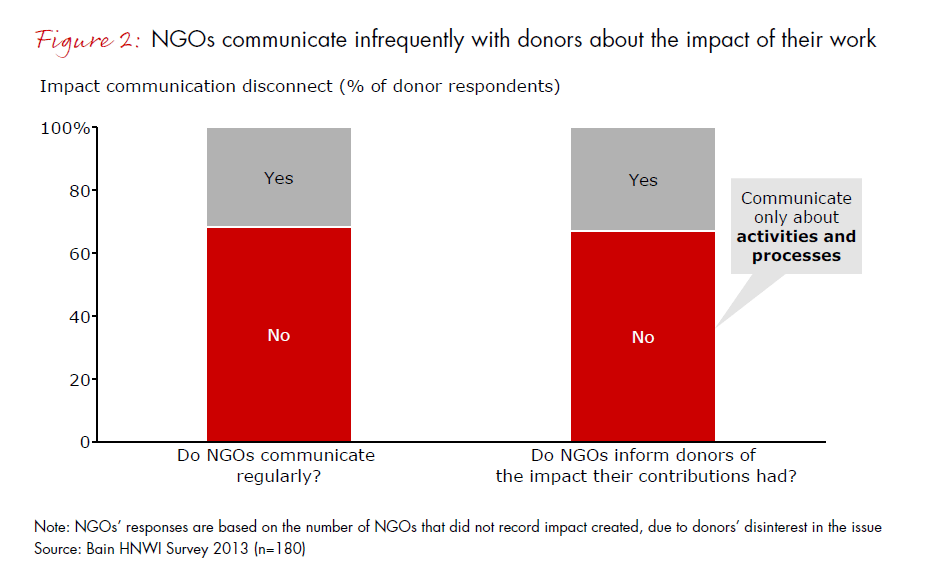
For NGOs to improve on this front, they should discuss the expectations on the quality and frequency of communications with donors at the beginning of a project. An early dialogue about impact can also help clarify what each party is seeking from the relationship.
Our interviews indicate that one major point of discord among NGOs is the need to sensitise donors about sector-specific challenges. If donors are educated about the complexities of the sector early in a programme’s lifecycle, they are more likely to appreciate the choices and trade-offs made by the NGOs—and less likely to be dissatisfied with the impact created.
Contradictory expectations exist between sophisticated and more conventional stakeholders
It is important to note that stakeholders’ profiles could vary greatly, depending on where they lie on the “philanthropic experience curve”, their primary motivations and their capabilities. Across both donors and NGOs, there is a continuum of participants that ranges from those who are motivated purely by emotional and personal reasons to those who bring sophisticated professional rigour to the field of giving.
Stakeholders consequently differ in their operational styles as well, from how they choose causes to fund to their expectations of the level and frequency of oversight they will have to the degree of their involvement with the project.
A few observations from our interviews:
Donors
- Conventional donors invest in philanthropy for personal, emotional and sometimes religious reasons, while sophisticated donors have clear mandates for creating sustainable and meaningful change in a chosen sector.
- Conventional donors lean towards projects that reach out to the maximum number of beneficiaries, and they often hold no specific long-term view of the sector or the NGO. That is not the case with sophisticated donors, who are more willing to commit for longer periods to foster systemic change.
- Sophisticated donors demand comprehensive assessment and often follow up with regular oversight, such as half-yearly reviews or annual personal visits. They follow a metric-driven decision-making process. Conventional donors, on the other hand, are more informal and loosely engaged. They do not approach their charitable giving with the same rigour that they may demand of their business or profession.
NGOs
- Sophisticated NGOs are aware of donors’ needs. They realise the significance of impact studies and use them to internally monitor and course-correct their programmes. They also understand the cost of such assessments and include such costs as part of the overall funding up front. Conventional NGOs, which constitute the majority of the universe, are more unstructured in their impact measurement and communication plans.
- Most NGOs tend to be satisfied with “activity” metrics, while the sophisticated players follow defined processes to identify, measure and disseminate impact-related data. Their processes stand up to the scrutiny of the most knowledgeable donors and large foundations.
The pain and complexity of impact assessment impede adoption by NGOs
Our research reveals that there are two broad dimensions of philanthropic impact:
- Quantity: The number of beneficiaries or the quantum of efforts. These activities and improvements are relatively easy to measure and often address coverage and reach issues. Some examples are the number of children completing their primary education and the number of health camps conducted in a district.
- Quality: Less obvious benefits. These improvements are complex and address deeper behaviour changes. Such changes are indicative of deeper systemic changes and are often difficult to measure, monitor and communicate. Some examples are greater interest in learning and the sustainability of the change after the philanthropic effort is stopped.
The NGOs surveyed by Bain testified to the measurement challenges associated with these dimensions. A full 40% find such efforts difficult, and a similar proportion cites the cost of evaluation as a deterrent (see Figure 3).
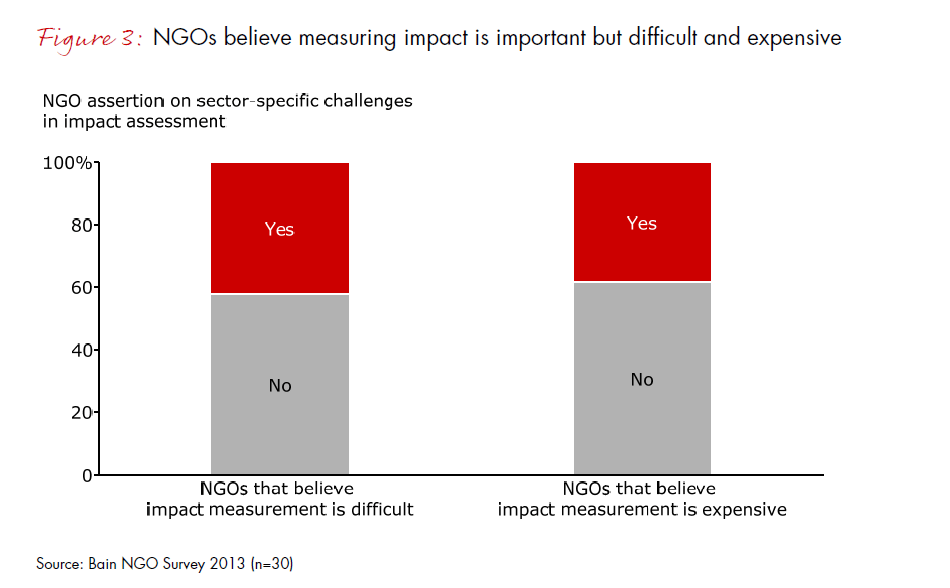
While those numbers do not sound overwhelming, our in-depth interviews revealed that NGOs in harder-to-measure sectors, such as gender justice, drug rehabilitation and Dalit empowerment, are feeling this measurement challenge most acutely. The benefits they create may be subtle and intangible, or only become visible over a long duration of time.
This predicament is exacerbated by the fact that donors are often reluctant to fund the costs of measuring results. NGOs in these sectors will continue to struggle with impact measurement unless efforts are made to research, define and standardise impact metrics relevant for them.
In all sectors, NGOs find it difficult to focus on both quality and quantity due to their operating constraints. Limited resources often ensure that they have to choose one over the other. The NGOs that we interviewed confirmed this inherent trade-off. For example, achieving the worthy goal of higher enrolment in schools can counteract the equally worthy goal of maintaining a healthy teacher-to-student ratio.
For those reasons, it is imperative that donors and NGOs align on what should be measured, and how and when that measurement should occur.
The upside to alignment: More than 25% of donors will give more if impact communication improves
To spur philanthropic contributions, it is crucial that impact becomes a central part of the conversation between donors and NGOs. Such efforts will not only increase confidence among the donor community in the value of their contributions, but they will also squeeze out the maximum efficiency of each philanthropic rupee. In addition, Bain’s survey of HNWIs reveals that validating impacts alone may encourage donors to hike up their philanthropic giving.
About two-thirds of the donors surveyed currently believe that NGOs have room to improve the impact they are making in the lives of beneficiaries (see Figure 4).
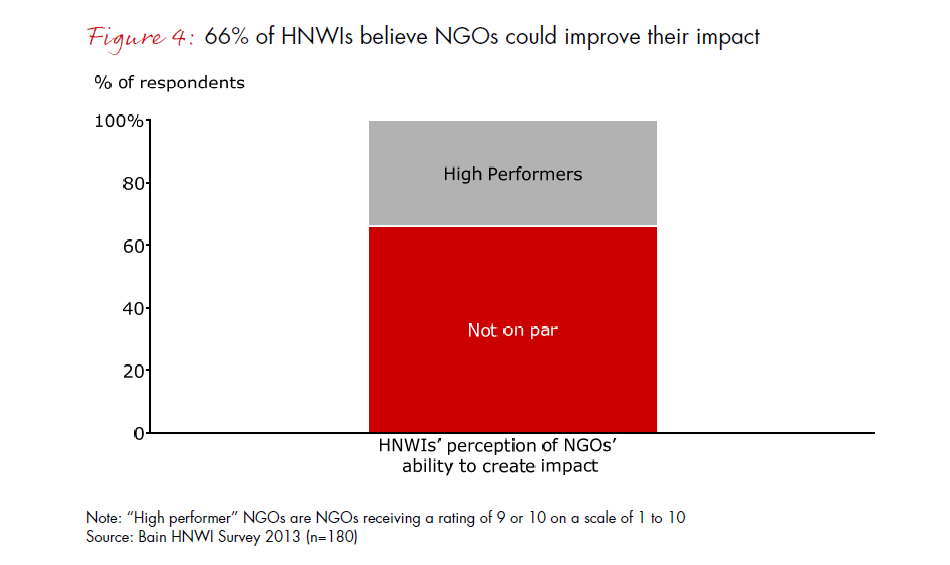
If NGOs could step up their game to improve their impact creation and communication, however, our survey finds that 26% of donors would increase their philanthropic contributions (see Figure 5).
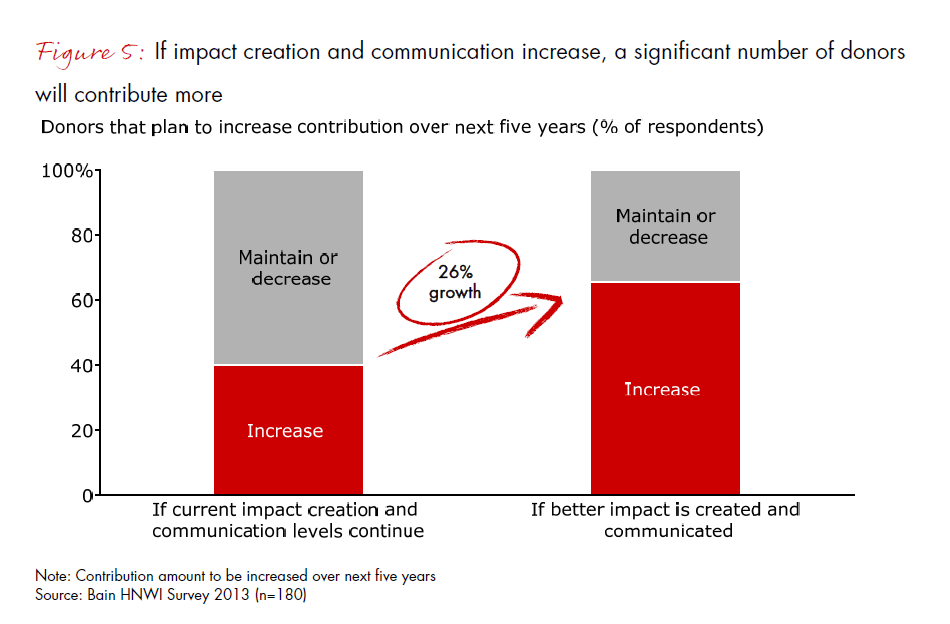
This is likely to create an uplift of about 20% in donations from impact-motivated HNWIs. Taking a more conservative view, that translates to an increase of 5% in the total private donation corpus.
That impact would be even higher—up to three times that amount—if institutions and foreign donors exhibited a similar increase in donations because they can see the results that can be achieved.
Needless to say, an additional donation base of this magnitude would have a significant impact for the end beneficiaries and more than justify the additional work that NGOs would have to assume to make it happen.
Learn from the best: The CHAHA programme from Alliance India
Background: Based in New Delhi, India, HIV/AIDS Alliance (Alliance India) is an NGO working in partnership with civil society and communities, to support sustained responses to HIV in India. Between 2007 and 2011, Alliance India implemented CHAHA, India’s first large-scale child-centred care and support programme for families and communities affected by HIV and AIDS. With support from the Global Fund, CHAHA was implemented in four states of India—Andhra Pradesh, Tamil Nadu, Maharashtra and Manipur—and has served more than 64,000 children in nearly 42,000 households affected by HIV.
Objective: CHAHA was a community-based care and support programme aimed at reducing HIV-related morbidity and mortality among children and adults, while ensuring social protection and stigma-free access to services.
Challenge: Measurement of impact is perceived to be difficult, particularly in sectors like this, where community interventions aim to change behaviours and empowerment efforts try to help marginalised populations. In this case, it was possible to measure and monitor the outcomes but difficult to arrive at their social, health, economic and environmental value in financial terms.
Approach: Alliance India worked out a framework of Social Return on Investment (SROI) for the CHAHA programme. Key features of this effort involved:
Stakeholder consultation and outcomes map. Stakeholders involved in the programme were identified, including affected children, their families, the government and others. Programme-led activities were distinguished from community advocacy initiatives and government efforts.
Outcomes, such as better financial status, improved employability due to school attendance and improved health, were measured. Other inputs unrelated to CHAHA were factored out. A financial value was placed on each outcome, in consultation with the beneficiaries and stakeholder groups. The value created was analysed in terms of which beneficiaries gained and which interventions created the most value.
Illustration of the process. One measure was the number of families counselled by fieldworkers to maintain a safe and hygienic environment at home. The outcome of that counselling was a reduction in the number of family health crises. A financial value was attached to the outcome by calculating the amount gained from the reduction in the number of lost work days from ill health. Each outcome was monetised similarly, creating a metric-driven template for evaluation and assessment in the sector.
Results: Alliance India found that for every Rs. 1 invested in the CHAHA programme, a social value of Rs. 4 was created. An innovative approach, coupled with careful planning and monitoring, created a compelling case for greater and sustained investment in the sector.
Call for action: What each of us can do
Based on our interactions with donors, NGOs, foundations and other experts, it is clear that there are best practices that can amplify the impact of every philanthropic rupee invested.
Here are a few of those practices for stakeholders in each category to consider:
If you are a donor
Apart from conducting a rigorous due diligence of the organisations they support, donors can get a bigger bang for their buck by setting expectations about impact at the start of the funding process. In addition, donors believe they can encourage better accountability by directing funds towards NGOs that adhere to industry standards (see Figure 6).
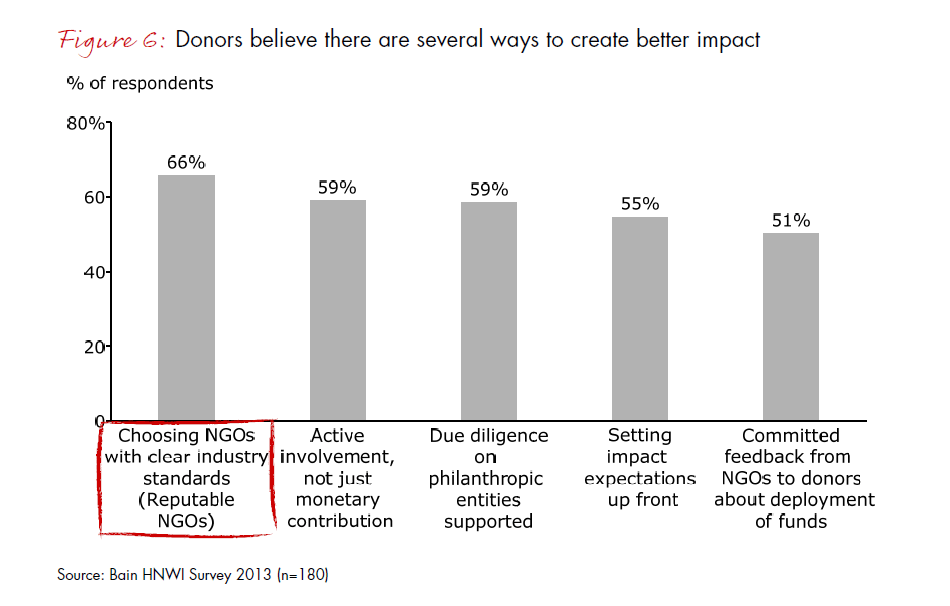
If you are an NGO
For NGOs, it may literally pay to focus on the composition of the top team and on creating a repeatable model to generate impact (see Figure 7). These are areas where financial backers may have great expertise. Getting donors and others in the community involved from the early stages of a project increases its chances of success.
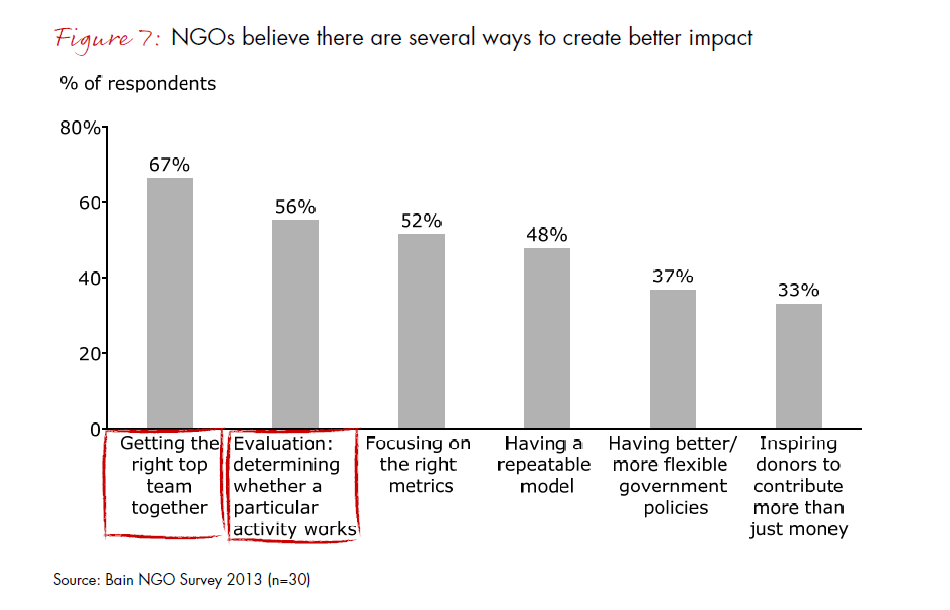
The NGOs must also use their years of experience to experiment with innovative methodologies and build metrics that are understandable by their largely corporate-minded, numbers-driven funders. Fund-raising for even difficult sectors might become easier when supported by solid research and credible pilot projects.
If you are a foundation
Foundations in the philanthropic arena can play a critical role in bridging the gap between NGOs and donors’ perceptions. Through their broad and deep linkages with all relevant stakeholders, foundations can play the role of a trusted intermediary for donors. Philanthropic givers can gain access to a set of screened NGOs and be assured of regular and stringent monitoring of the usage of funds.
Conversely, foundations can and do coach NGOs on the importance and methodologies of impact assessment while giving them the flexibility to define their own metrics and monitoring mechanism.
From a sector perspective, foundations, because of their capacity for long-duration involvement in any project and ability to run impact studies, can also ensure that complex issues, where assessing impact is difficult, are well researched and relevant impact metrics are defined.
Conclusion
Achieving congruence on results-related issues can help increase the impact of philanthropy in India—and possibly even the overall level of philanthropy in the country. However, that will not be an easy goal.
Donors will benefit from making efforts to understand specific-sector challenges and the various methods to tackle them at the beginning of projects.
NGOs will benefit from clearly articulating their goals and the expected routes to achieve them. Frequent and more detailed communication from NGOs to donors can improve their credentials.
Foundations could support NGOs in testing innovative approaches to difficult and underrepresented sectors with their longer-range vision and ability to fund qualitative, impact-producing activities, such as advocacy, policy and research efforts.
In addition, Bain believes that the philanthropic ecosystem, comprised of donors, foundations, NGOs and the government, needs to come together on the issue of impact definition.
The time has come for like-minded stakeholders in India’s philanthropic community to come together to define and popularise sector-specific impact metrics. As our research indicates, the payoffs of such an initiative for all stakeholders and, more importantly, for the final beneficiaries will be manifold.
References
- Ministry of Statistics and Programme Implementation (Government of India) website, press releases, http://mospi.nic.in, accessed on 26 February 2013.
- Planning Commission of India. Twelfth Five Year Plan Social Sectors—Volume III, 2008.
- Pratham, Provisional report on “Annual Report on Status of Education (Rural) 2012”, 2013.
- Ministry of Human Resource Development (Government of India), “Working Group Report on Elementary Education and Literacy, 12th Five Year Plan 2012–2017”, 2011.
- Planning Commission of India, High-level expert group report on “Universal Health Coverage for India”, 2011.
- UNHDR website, Human Development Indicators, http://hdrstats.undp.org/en/countries/profiles/IND.html accessed on 26 February 2013.
- Planning Commission of India, Voluntary Action Cell proceedings of “All India Conference on the Role of the Voluntary Sector in National Development”, 2002.
- Biswas K, Kummarikunta G, Biswas A, Tong L, Social Return on Investment: CHAHA programme, International HIV/AIDS Alliance, 2010.
1Individuals with more than Rs. 5 cr investible assets
Acknowledgements
This report was prepared by Arpan Sheth, partner with Bain & Company, who leads its Private Equity practice; Anant Bhagwati, principal with Bain & Company; and Gaurav Rekhi, manager with Bain & Company.
The authors thank consultants Varun Saini, Pallavi Khare and Shruti Pyare for their contributions with survey analysis and key insights generation, and Shalini S. Dagar, Elaine Cummings and Maggie Locher for their editorial support. They also thank Mukesh Kaura and Sumeet Chopra for his design support.
The authors also thank Dasra for helping to develop the perspectives outlined in this report. Dasra is a leading philanthropic foundation in India. It works with philanthropists and successful social entrepreneurs to bring together knowledge, funding and people as a catalyst for social change. Over the last 13 years, Dasra has worked with more than 250 social-sector organisations and directed Rs. 55 crore funding into the nonprofit sector.
This work is based on secondary market research, analysis of financial information available or provided to Bain & Company and a range of interviews with industry participants. Bain & Company has not independently verified any such information provided or available to Bain and makes no representation or warranty, express or implied that such information is accurate or complete. Projected market and financial information, analyses and conclusions contained herein are based on the information described above and on Bain & Company’s judgment, and should not be construed as definitive forecasts or guarantees of future performance or results. The information and analysis herein does not constitute advice of any kind, is not intended to be used for investment purposes, and neither Bain & Company nor any of its subsidiaries or their respective officers, directors, shareholders, employees or agents accept any responsibility or liability with respect to the use of or reliance on any information or analysis contained in this document. This work is copyright Bain & Company and may not be published, transmitted, broadcast, copied, reproduced or reprinted in whole or in part without the explicit written permission of Bain & Company.






